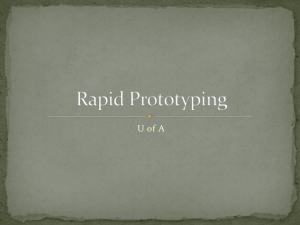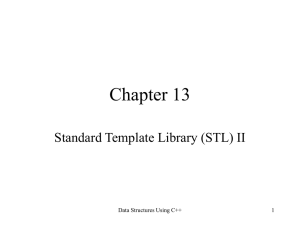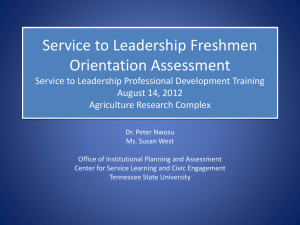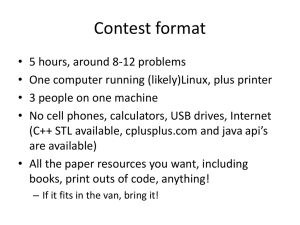Chapter13
advertisement
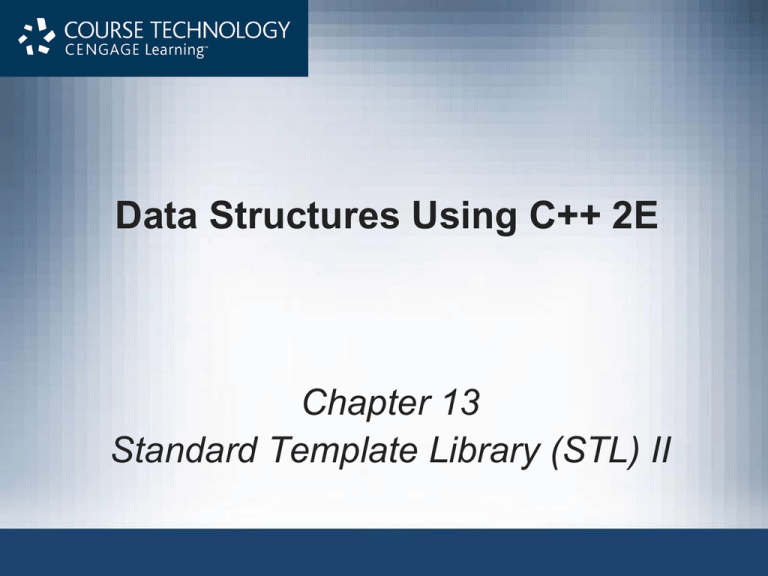
Data Structures Using C++ 2E Chapter 13 Standard Template Library (STL) II Objectives • Learn more about the Standard Template Library (STL) • Become familiar with associative containers • Explore how associative containers are used to manipulate data in a program • Learn about various generic algorithms Data Structures Using C++ 2E 2 Class pair • Allows two values to be combined into a single unit – Treated as one unit – Functions using class pair • Return two values • Using the class pair in a program – class pair definition contained in header file utility – Include statement: #include <utility> Data Structures Using C++ 2E 3 Class pair (cont’d.) • class pair constructors – Default constructor – Constructor with two parameters • Type pair object – Two public data members: first, second • See Example 13-1 Data Structures Using C++ 2E 4 Comparing Objects of Type pair • Relational operators – Overloaded for class pair TABLE 13-1 Relational operators for the class pair Data Structures Using C++ 2E 5 Type pair and Function make_pair • Header file utility – Contains definition of function template make_pair • Create pairs without explicitly specifying type pair – With function make_pair • Function template make_pair – Value returning function • Returns a value of type pair Data Structures Using C++ 2E 6 Associative Containers • Elements automatically sorted – According to some ordering criteria – Default ordering criterion • Relational operator < (less than) • Users can specify own ordering criterion • New element inserted at the proper place • Binary search tree – Convenient and fast way to implement data structure • Four predefined associative containers Data Structures Using C++ 2E 7 Associative Containers: set and multiset TABLE 13-2 Various ways to declare a set/multiset container Data Structures Using C++ 2E 8 Associative Containers: set and multiset (cont’d.) TABLE 13-2 Various ways to declare a set/multiset container (continued) Data Structures Using C++ 2E 9 Associative Containers: set and multiset (cont’d.) TABLE 13-3 Operations to insert or delete elements from a set Data Structures Using C++ 2E 10 Associative Containers: map and multimap • Manage elements in the form key/value • Sorting elements – Automatically according to sort criteria applied on key • Default sorting criterion: relational operator < (less than) – User can specify sorting criteria • User-defined data types and relational operators – Must be properly overloaded Data Structures Using C++ 2E 11 Associative Containers: map and multimap (cont’d.) • Difference between map and multimap – Container multimap allows duplicates – Container map does not • Class name defining container map: map • Class name defining container multimap: multimap • Use include statement: #include <map> Data Structures Using C++ 2E 12 Associative Containers: map and multimap (cont’d.) TABLE 13-4 Various ways to declare a map/multimap container Data Structures Using C++ 2E 13 Associative Containers: map and multimap (cont’d.) TABLE 13-4 Various ways to declare a map/multimap container (continued) Data Structures Using C++ 2E 14 Associative Containers: map and multimap (cont’d.) TABLE 13-5 Operations to insert or delete elements from a map or multimap Data Structures Using C++ 2E 15 Containers, Associated Header Files, and Iterator Support TABLE 13-6 Containers, their associated header files, and the type of iterator supported by each container Data Structures Using C++ 2E 16 Algorithms • Some operations specific to a container – Provided as part of container definition • Generic algorithms – Common to all containers • Contained in header file algorithm – Examples • Find • Sort • Merge Data Structures Using C++ 2E 17 STL Algorithm Classification • Algorithms may be tied to a specific container – Members of a specific class – Examples: clear, sort, merge • Generic algorithms – Applied in a variety of situations • STL generic algorithm classifications – – – – Nonmodifying algorithms Modifying algorithms Numeric algorithms Heap algorithms Data Structures Using C++ 2E 18 Nonmodifying Algorithms • Do not modify container elements • Investigate the elements TABLE 13-7 Nonmodifying algorithms Data Structures Using C++ 2E 19 Modifying Algorithms • Modify container elements by – Rearranging, removing, changing element values • Mutating algorithms – Modifying algorithms that change element order • Not element values – Examples • next_permutation, partition, prev_permutation, random_shuffle, reverse, reverse_copy, rotate, rotate_copy, stable_partition Data Structures Using C++ 2E 20 Modifying Algorithms (cont’d.) TABLE 13-8 Modifying algorithms Data Structures Using C++ 2E 21 Numeric Algorithms • Designed to perform numeric calculations container elements TABLE 13-9 Numeric algorithms Data Structures Using C++ 2E 22 Heap Algorithms • Based on heapsort algorithm operation TABLE 13-10 Heap algorithms Data Structures Using C++ 2E 23 Function Objects • Generic algorithm flexibility – STL provides two forms of an algorithm • Using function overloading • First algorithm form – Uses natural operation to accomplish goal • Second algorithm form – User specifies criteria Data Structures Using C++ 2E 24 Function Objects (cont’d.) • Function object – Contains a function • Treated as a function using function call operator, () – Class template • Overloads the function call operator, () – STL allows creation of own function objects • STL provides arithmetic, relational, logical function objects • STL’s function objects – Contained in header file functional Data Structures Using C++ 2E 25 Function Objects (cont’d.) TABLE 13-11 Arithmetic STL function objects Data Structures Using C++ 2E 26 Function Objects (cont’d.) TABLE 13-12 Relational STL function objects Data Structures Using C++ 2E 27 Function Objects (cont’d.) TABLE 13-12 Relational STL function objects (continued) Data Structures Using C++ 2E 28 Function Objects (cont’d.) TABLE 13-13 Logical STL function objects Data Structures Using C++ 2E 29 Predicates • Special types of function objects – Return Boolean values • Unary predicates – Check a specific property for a single argument • Binary predicates – Check a specific property for a pair of (two) arguments Data Structures Using C++ 2E 30 Predicates (cont’d.) • Typical use – Specifying searching, sorting criterion • In STL – Always return same result for same value • Functions modifying their internal states – Cannot be considered predicates Data Structures Using C++ 2E 31 Predicates (cont’d.) • Insert iterator – STL provides three insert iterators • To insert elements at destination • Class vector – Does not support the push_front operation • Cannot be used for a vector container Data Structures Using C++ 2E 32 Predicates (cont’d.) • back_inserter – Uses the push_back operation of the container in place of the assignment operator • front_inserter – Uses the push_front operation of the container in place of the assignment operator • inserter – Uses the container’s insert operation in place of the assignment operator Data Structures Using C++ 2E 33 STL Algorithms • Many STL algorithms available • Section coverage – Function prototypes – Brief description of what the algorithm does – Program showing how to use algorithm • Section conventions – In the function prototypes • Parameter types indicate for which type of container the algorithm is applicable – Abbreviations used Data Structures Using C++ 2E 34 STL Algorithms (cont’d.) • Functions fill and fill_n – Function fill • Fills a container with elements – Function fill_n • Fills in the next n elements • Functions generate and generate_n – Both generate elements and fill a sequence • Functions find, find_if, find_end, and find_first_of – All are used to find the elements in a given range Data Structures Using C++ 2E 35 STL Algorithms (cont’d.) • Functions remove, remove_if, remove_copy, and remove_copy_if – Function remove • Removes certain elements from a sequence – Function remove_if • Removes elements from a sequence • Using some criterion Data Structures Using C++ 2E 36 STL Algorithms (cont’d.) • Functions remove, remove_if, remove_copy, and remove_copy_if (cont’d.) – Function remove_copy • Copies the elements in a sequence into another sequence • By excluding certain elements from the first sequence – Function remove_copy_if • Copies elements in a sequence into another sequence • By excluding certain elements, using some criterion, from the first sequence Data Structures Using C++ 2E 37 STL Algorithms (cont’d.) • Functions replace, replace_if, replace_copy, and replace_copy_if – Function replace • Replaces all the occurrences, within a given range, of a given element with a new value – Function replace_if • Replaces the values of the elements, within a given range, satisfying certain criteria with a new value Data Structures Using C++ 2E 38 STL Algorithms (cont’d.) • Functions replace, replace_if, replace_copy, and replace_copy_if (cont’d.) – Function replace_copy • Combination of replace and copy – Function replace_copy_if • Combination of replace_if and copy Data Structures Using C++ 2E 39 STL Algorithms (cont’d.) • Functions swap, iter_swap, and swap_ranges – Used to swap elements • Functions search, search_n, sort, and binary_search – Used to search elements Data Structures Using C++ 2E 40 STL Algorithms (cont’d.) • Functions adjacent_find, merge, and inplace_merge – Function adjacent_find • Finds the first occurrence of consecutive elements satisfying a certain criterion – Algorithm merge • Merges two sorted lists – Algorithm inplace_merge • Combines two sorted, consecutive sequences Data Structures Using C++ 2E 41 STL Algorithms (cont’d.) • Functions reverse, reverse_copy, rotate, and rotate_copy – Algorithm reverse • Reverses the order of the elements in a given range – Algorithm reverse_copy • Reverses the elements in a given range while copying into a destination range • Source not modified Data Structures Using C++ 2E 42 STL Algorithms (cont’d.) • Functions reverse, reverse_copy, rotate, and rotate_copy (cont’d.) – Algorithm rotate • Rotates the elements in a given range – Algorithm rotate_copy • Copies the elements of the source at the destination in a rotated order Data Structures Using C++ 2E 43 STL Algorithms (cont’d.) • Functions count, count_if, max_element, min_element, and random_shuffle – Algorithm count • Counts occurrences of a given value in a given range – Algorithm count_if • Counts occurrences of a given value in a given range satisfying a certain criterion – Algorithm max_element • Determines the largest element in a given range Data Structures Using C++ 2E 44 STL Algorithms (cont’d.) • Functions count, count_if, max_element, min_element, and random_shuffle (cont’d.) – Algorithm min_element • Determines the smallest element in a given range – Algorithm random_shuffle • Used to randomly order the elements in a given range Data Structures Using C++ 2E 45 STL Algorithms (cont’d.) • Functions for_each and transform – Algorithm for_each • Used to access and process each element in a given range by applying a function, which is passed as a parameter – Function transform • Creates a sequence of elements by applying certain operations to each element in a given range Data Structures Using C++ 2E 46 STL Algorithms (cont’d.) • Functions includes, set_intersection, set_union, set_difference, and set_symmetric_difference – Algorithm includes • Determines whether the elements of one range appear in another range – Algorithm set_intersection • Finds the elements that are common to two ranges of elements – Algorithm set_union • Finds the elements that are contained in two ranges of elements Data Structures Using C++ 2E 47 STL Algorithms (cont’d.) • Functions includes, set_intersection, set_union, set_difference, and set_symmetric_difference (cont’d.) – Algorithm set_difference • Finds the elements in one range of elements that do not appear in another range of elements – Given two ranges of elements, the algorithm set_symmetric_difference • Determines the elements that are in the first range but not the second range, or the elements that are in the second range but not the first range Data Structures Using C++ 2E 48 STL Algorithms (cont’d.) • Functions accumulate, adjacent_difference, inner_product, and partial_sum – All are numerical functions • Manipulate numeric data Data Structures Using C++ 2E 49 Summary • This chapter discussed – – – – – The Standard Template Library (STL) Associative containers Operations on associative containers Function and algorithms on associative containers Examples of the use of function and algorithms Data Structures Using C++ 2E 50
